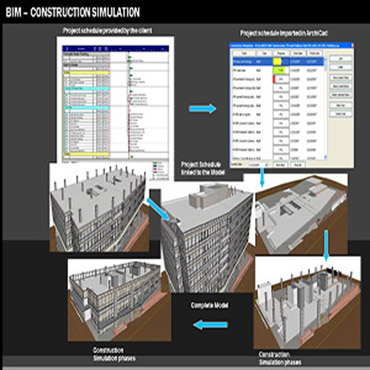Our BIM Services
Our BIM Services
At BIM CONSULTING, we are pleased to share our knowledge and experience participating in helping AEC firms in transition from CAD to BIM. Partnering BIM requirements with us help our clients, to focus on their core competency and construction processes. We work as an extended hand to our clients and help them manage their resources effectively. By virtue of having varied experience in the AEC industry, our services include:
BIM Services
An intelligent 3D virtual building database, with all disciplines coordinated, created, used and maintained, throughout the lifecycle of a building project
- A. Architectural Modelling
- B. Structural Modelling
- C. MEP Modelling; and
- D. Clash Detection.
BIM Implementation Services
Building Information Modelling (BIM) today presents a new and unique set of challenges for the infrastructure industry. We assist AEC and Facility Management firms in transition from CAD to BIM and to achieve BIM benefits. We also, assist organizations in making a BIM business transformation a reality by working with them as an extended team, till they are fully equipped.
BIM IMPLEMENTATION PLAN:
- • Evaluate the existing BIM capabilities
- • Conduct BIM workshop to the stakeholders, showcasing the benefits
- • Recommend the changes required in the existing set-up
- • Provide BIM training
- • Dedicate BIM resource or team for trouble shooting and hand holding till smooth transition.
Clash Detection Services.
One of the key benefits of BIM is the ability to spot 'clashes' at an early stage in your project where they should be much easier, cheaper and less time consuming to rectify.
Clash occurs when components that make up a built asset are not spatially coordinated and conflict. In a BIM process these clashes can be spotted more easily during the design phase of a project ahead of work starting on site.
BIM modelling software and BIM integration tools allow designers to check for clashes in their own models and when models are combined.
Content Creation BIM Services.
The need of custom BIM families for creating an intelligent 3D model is essential. Manufactures providing custom families for their products are more likely to be chosen by designers and BIM consultants firms to specify there needs on various projects.
We provide customized solutions for product manufactures, fabricators, architects, contractors and engineers who can get there products modelled according to their requirements using Autodesk Revit platform, by creating emphasis on object parameters both in geometrical and information aspects.
Quantity Take - Offs
Estimators within construction firms have traditionally been using blueprints and other types of 2-D plan sheets for project estimates. Every single sheet of the project plans had to be reviewed, calculating the amount of specific materials needed while also being sure not to double count or disregard any material. In addition to accounting for material needed for the construction of a project, waste factors had to be calculated as well. This process being time consuming and very detail oriented, and due to a large number of variables, mistakes often used occur.
However, with recent technological developments in 3-D modeling, the way projects are being designed, estimated, and delivered is becoming more efficient. Building Information Modeling (BIM) software has allowed the industry to begin to move toward BIM-based quantity take-off (QTO) and estimating. Three-dimensional models developed in BIM programs are data-rich, intelligent models that have the ability to link individual elements to the material it represents in the model. This intelligence has the ability to accelerate the QTO for a construction project while increasing the accuracy of the estimate.
Energy Analysis, Cost & Time Optimization
The BIM Use of Facility Energy Analysis is a process in the facility design phase which one or more building energy simulation programs use a properly adjusted BIM model to conduct energy assessments for the current building design. The core goal of this BIM use is to inspect building energy standard compatibility and seek opportunities to optimize proposed design to reduce structure's life-cycle costs.
Potential Value:
- • Save time and costs by obtaining building and system information automatically from BIM model instead of inputting data manually
- • Improve building energy prediction accuracy by auto-determining building information such as geometries, volumes precisely from BIM model
- • Help with building energy code verification
- • Optimize building design for better building performance efficiency and reduce building life-cycle cost
Resources Required:
- • Building Energy Simulation and Analysis Software(s)
- • Well-adjusted Building 3D-BIM Model
- • Detailed Local Weather Data
- • National/Local Building Energy Standards (e.g. ASHRAE Standard 90.1)



























